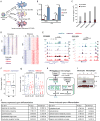Epigenetic programming of monocyte-to-macrophage differentiation and trained innate immunity
- PMID: 25258085
- PMCID: PMC4242194
- DOI: 10.1126/science.1251086
Epigenetic programming of monocyte-to-macrophage differentiation and trained innate immunity
Abstract
Monocyte differentiation into macrophages represents a cornerstone process for host defense. Concomitantly, immunological imprinting of either tolerance or trained immunity determines the functional fate of macrophages and susceptibility to secondary infections. We characterized the transcriptomes and epigenomes in four primary cell types: monocytes and in vitro-differentiated naïve, tolerized, and trained macrophages. Inflammatory and metabolic pathways were modulated in macrophages, including decreased inflammasome activation, and we identified pathways functionally implicated in trained immunity. β-glucan training elicits an exclusive epigenetic signature, revealing a complex network of enhancers and promoters. Analysis of transcription factor motifs in deoxyribonuclease I hypersensitive sites at cell-type-specific epigenetic loci unveiled differentiation and treatment-specific repertoires. Altogether, we provide a resource to understand the epigenetic changes that underlie innate immunity in humans.
Copyright © 2014, American Association for the Advancement of Science.
Figures





Comment in
-
Macrophages: innate memory training.Nat Rev Immunol. 2014 Nov;14(11):713. doi: 10.1038/nri3759. Epub 2014 Oct 10. Nat Rev Immunol. 2014. PMID: 25301255 No abstract available.
References
-
- Lewis JS, Lee JA, Underwood JC, Harris AL, Lewis CE. Macrophage responses to hypoxia: relevance to disease mechanisms. J Leukoc Biol. 1999;66:889–900. - PubMed
-
- Auffray C, Sieweke MH, Geissmann F. Blood monocytes: development, heterogeneity ,and relationship with dendritic cells. Annu Rev Immunol. 2009;27:669–692. - PubMed
-
- Ginhoux F, Jung S. Monocytes and macrophages: developmental pathways and tissue homeostasis. Nat Rev Immunol. 2014;14:392–404. - PubMed
Publication types
MeSH terms
Substances
Associated data
- Actions
Grants and funding
LinkOut - more resources
Full Text Sources
Other Literature Sources
Molecular Biology Databases

